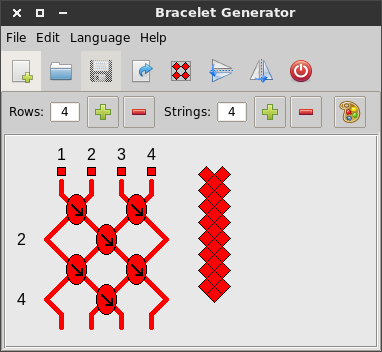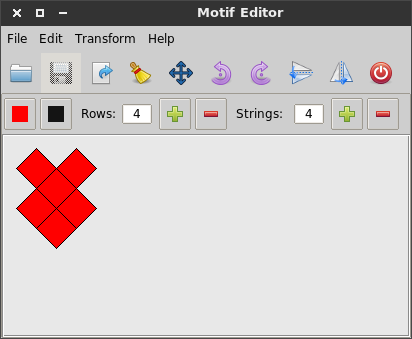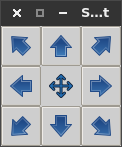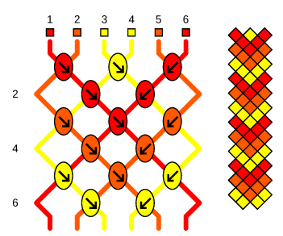Copyright © 2014-2017 Juliette Monsel.
This program is free software: you can redistribute it and/or modify it under the terms of the GNU General Public License as published by the Free Software Foundation, either version 3 of the License, or (at your option) any later version.
This program is distributed in the hope that it will be useful, but WITHOUT ANY WARRANTY; without even the implied warranty of MERCHANTABILITY or FITNESS FOR A PARTICULAR PURPOSE. See the GNU General Public License for more details.
You should have received a copy of the GNU General Public License along with this program. If not, see http://www.gnu.org/licenses/.
Visit Bracelet Generator project page on Github for the latest updates.
This software does not aim at teaching you how to make friendship bracelets. It only enables you to create patterns easily. So if you do not know how to make the four types of knots, find a tutorial on the Internet first, for instance friendship-bracelets.net
Launch bracelet-generator-x.y.z.exe and follow the instructions given by the installer (you will need the administrator rights).
Bracelet Generator is available in the PPA ppa:j-4321-i/ppa.
$ sudo add-apt-repository ppa:j-4321-i/ppa
$ sudo apt-get update
$ sudo apt-get install bracelet-generator
Bracelet Generator is available in AUR.
The Mac version is outdated. If you want the latest version, use the source code instead.
Unzip the archive. Move BraceletGenerator.app to the /Applications. To be able to export patterns in .png or .jpg, you need to install Ghostscript. It can be done with brew:
$ brew install ghostscript
Otherwise refer to Ghostscript website.First, you need to install a few dependencies if they are missing:
Python 3 is certainly already installed, but you might need to install the others. The names of the packages vary between distributions. Here are the package names for:
You can also use pip to install Pillow (requires superuser rights):
$ pip3 install pillow
Unzip the archive and double click on bracelet-generator.py.
If nothing appends, right-click on the file and edit its properties to make it executable
or run it with python: open a console in the exctracted folder and run
$ python3 bracelet-generator.py
You can also install Bracelet Generator (requires superuser rights) with
$ python3 setup.py install
Then, it can be launched from the console with$ bracelet-generator
Tkinter will be installed automatically with Python. But you will need to install its library Pillow separately. You also need to install Ghostscript.
Unzip the archive and run add_gs_to_path.py to add Ghostscript location to the system path variable so that Bracelet Generator can find it. Then, launch bracelet-generator.py.
I have only tested Bracelet Generator under Ubuntu (16.04 LTS), ArchLinux and Windows (7 and 10) and Mac OS X (El Capitan), so I do not know which problems you might encounter on other operating systems.
$ pip3 install pillow
$ brew install Ghostscript
Tkinter is sometimes included in Python standard distribution or is available as a binary package (for Linux or BSD). If you are using Mac OS X , you can refer to https://www.python.org/download/mac/tcltk.
Unzip the archive and double click on bracelet-generator.py.
If nothing appends, you can try to define python as the default software to use to open it.
You can also launch it from the command line with something similar too:
$ python3 bracelet-generator.py
The software supports French and English. I translated it with gettext so, if you want to add or improve a translation, you're welcome , the BraceletGenerator.pot file is in the po/ folder of the source code.

 or
or
 buttons.
You can also directly set the number of rows / strings in the entries next to the buttons
buttons.
You can also directly set the number of rows / strings in the entries next to the buttons

 Create a new pattern (erase the current one).
Create a new pattern (erase the current one).
 Open a .bracelet file (erase the current pattern).
Open a .bracelet file (erase the current pattern).
 Save the current pattern.
Save the current pattern.
 Save the current pattern as a .bracelet file.
Save the current pattern as a .bracelet file.
 Export the current pattern as a .png, .jpg or .ps file.
Export the current pattern as a .png, .jpg or .ps file.
 Open the two-colored motif editor.
When the pattern will be generated, the previous pattern will be erased.
Open the two-colored motif editor.
When the pattern will be generated, the previous pattern will be erased.
 Perform a vertical symmetry of the pattern.
Perform a vertical symmetry of the pattern.
 Perform a horizontal symmetry of the pattern.
Perform a horizontal symmetry of the pattern.
 Quit.
Quit.
The color manager enables you to change the default color
of the strings and to change the color of all strings of a
given color.

The two-colored motif editor enables you to freely design a two-colored motif and then,
the pattern is automatically generated.

 /
/  .
.  or
or
 buttons.
You can also directly set the number of rows / strings in the entries next to the buttons
buttons.
You can also directly set the number of rows / strings in the entries next to the buttons
 .
.
 Open a .bicolor file (erase the current motif).
Open a .bicolor file (erase the current motif).
 Save the current motif.
Save the current motif.
 Generate the pattern corresponding to the motif.
It destroys the motif, so save it before if you want to edit it later.
Generate the pattern corresponding to the motif.
It destroys the motif, so save it before if you want to edit it later.
 Clear the motif. Be careful, you cannot undo this operation.
Clear the motif. Be careful, you cannot undo this operation.
 Open the translation tool.
Open the translation tool.
 Rotate the motif counter-clockwise.
Rotate the motif counter-clockwise.
 Rotate the motif clockwise.
Rotate the motif clockwise.
 Perform a vertical symmetry of the motif.
Perform a vertical symmetry of the motif.
 Perform a horizontal symmetry of the motif.
Perform a horizontal symmetry of the motif.
 Quit the editor.
Quit the editor.
The translation tool enables you to shift periodically the motif in the directions given by the arrows.

Some basic examples are given in the examples/ folder (located in
/usr/share/bracelet-generator if you installed the .deb package, or in your_user_folder/BraceletGenerator
if you installed the software from the sources or with the .exe), such as a chevron bracelet:

Enjoy and create amazing patterns !
If you encounter errors when trying to export a pattern in .png or .jpg, or if no file is created, check whether Ghostscript is installed on your computer. If it is not the case, install it and export should work. If you are using Windows, run C:\Program Files\Bracelet Generator\add_gs_to_path.exe (or add_gs_to_path.py if you are using the source code) to add Ghostscript location to the system path variable.
If you encounter other problems, bugs or if you have comments, open a ticket on the project page or write me an email at j_4321@protonmail.com.